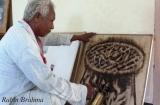Archives
Artists in North East remember MF Hussain’s contributions
The Camp was held at Shilpgram from the 6th to the 11th of June and the same saw the participation of around 19 artistes from the Northeast and other parts of the country. Coordinated by Sanajaoba Temsuba from Manipur, the camp was inaugurated by senior Assamese artist Noni Borpujari.
 So while Rabiram Brahma was seen practicing his ‘wood-burn’ brand of art, Debananda Ulup was working on his new series of three-dimensional objects, enabling the young artistes who had assembled in the camp to see how one can play with objects and colours.
So while Rabiram Brahma was seen practicing his ‘wood-burn’ brand of art, Debananda Ulup was working on his new series of three-dimensional objects, enabling the young artistes who had assembled in the camp to see how one can play with objects and colours.
A post graduate degree holder from the MS University of Baroda, Brahma runs an artist village in his native town of Udalguri. Besides filling a vital gap in the folk-cultural mileu, the need for fostering unity among the cast Assamese and Bodo communities is reflected in his works, which lays bare the recurrent ethnic conflicts between these two groups of people.
For Gautam Noarem, a student of the fine arts department of Assam University in Silchar, the camp provided the perfect opportunity to interact with other artistes of the region. “The camp has been an enlightening experience. While we tend to work on our ideas in our own individual styles, this kind of networking provides us the opportunity to know what others are doing, their treatment of similar ideas and also to exchange thoughts.”
Alpana Phukan, who runs an art school in the city and whose works basically revolve around child issues, said, “I got to meet a few new artistes from the region and places like Andhra Pradesh, Gujarat and Madhya Pradesh, and picked up a few new techniques from them.” Meanwhile, Ratumoni Das, a physically challenged artist from Tezpur, was seen experimenting with monochromatic shades in a normal deviation from his multicolour works.
The sculptors were also busy with their graphite stone and sandstones. Umesh Nayak from Aligarh, who was creating a sculpture of the life cycle, said, “I prefer sandstone to graphite as it is much softer. The camp has been a revealing one as the tribal motifs and designs used by some of the new artists are very interesting.”
The second day of the camp, however, saw a mild disruption on account of the death of arguably the best known Indian artist MF Hussain. Responsible for ushering in the wave of contemporary art in the country, Hussain had opened new doors of possibilities for artists of the country. Graphic artist Dilip Tamuly, whose work on Karbi folk culture has been displayed in an entire section in the Oslo museum of Norway and who had chanced upon the late artist at close quarters, said, “Contemporary Indian art owes its resurgence only to him.” A special condolence meeting was held on the occasion where the voice of Rabiram echoed, “Hussain passed away today but he will continue to live through his work.”
The confluence of colours and cultures ended in a positive note with an exhibition of all the works produced in the camp followed by a valedictory function presided over by Dilip Tamuly. The art works produced during the camp are being displayed in a special pavilion at Shilpgram.

